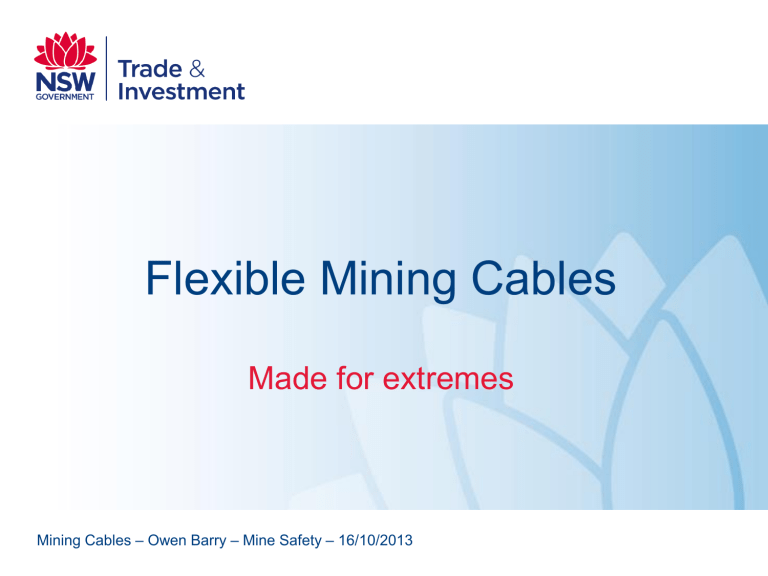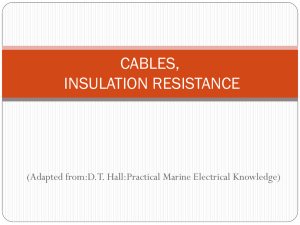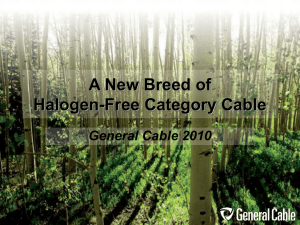Flexible Mining Cables

Flexible Mining Cables
Made for extremes
Mining Cables – Owen Barry – Mine Safety – 16/10/2013
From
Picture courtesy of NSW T&I Image Library
To
Picture courtesy of NSW T&I Image Library
And
Picture courtesy of NSW T&I Image Library
From
Picture courtesy of NSW T&I Image Library
To
Picture courtesy of NSW T&I Image Library
And
Picture courtesy of NSW T&I Image Library
Cable damage
Likelihood of cable damage is elevated
– Machines are big and mobile
– Cables being dragged and pulled
– Some are continually reeled
– Other large equipment moving in close proximity to cables
Connection to mine earth dependent on integrity of cable
Risk from cable damage
Electrocution
Electric shock
Ignition of gas or dust
Fires
Burns (proximity to arc flash)
Controls to minimise risks
- from cable damage
Cable management plans
– Training of personnel
– Placement of cables
– Cable handling equipment
IT supply systems
– 1 st fault is low energy earth fault
Electrical protection systems
– Sensitive earth leakage
Cables constructed to set standards
– AS/NZS 1802
– AS/NZS 1972
– AS/NZS 2802
Cable handling – O/Cut
Standards for mining cables
AS/NZS 1802:2003 Electric cables —Reeling and trailing —For underground coal mining
AS/NZS 1972:2006 Electric cables —Underground coal mines —Other than reeling and trailing
AS/NZS 2802:2000 Electric cables —Reeling and trailing —For mining and general use (other than underground coal mining)
Cable design
Earth screened
– Damage to earth before another phase
Voltage rated for line to earth, not phase to earth
– Function of the IT supply system
Solid construction gives impact resistance
Sheath materials resistant to:
– Cuts, abrasions and tears
– Water ingress
– Chemicals – UV, oils and greases, acids & alkali
– Heat
Extreme cable handling
Example of poor cable handling.
Dragline cables being towed behind a dozer
AS/NZS 1802:2003
Scope
Reeling and trailing electric cables for use in underground coal mines.
Cables used for alternating current supply must be electrically symmetrical.
Specifies construction and dimensional requirements for specific types of cables
Cable constructions – Type 240
Cable constructions – Type 241
AS/NZS 1972:2006
Scope
Specifies the construction of cables for use in underground coal mines other than reeling and trailing cables, ie
– Reticulation/feeder cables
– Machine cables
– Mine shaft winder cables
Generally, does not apply to cables for IS circuits, data, communication and control cables unless specifically covered.
AS/NZS 2802:2003
Scope
Intended for:
– surface mining,
– underground mining (other than coal mining), and
– general use,
Allows for two classes of multicore, elastomer insulated and sheathed flexible reeling and trailing cables.
No requirement for symmetrical construction
Cable construction – Type 450
AS/NZS 2802:2003
Class 1 cables
Insulated with a high grade ethylene propylene rubber (XR-EP-90)
Permits a reduced radial thickness for the insulation compared with equivalent rated Class 2 cables
Cable sheath is extra-heavy duty (XHD-90-CSP,
XHD-90-CPE or XHD-85-PCP)
Designed for slow reeling or trailing applications
AS/NZS 2802:2003
Class 2 cables
Insulated using standard R-EP-90 insulation
Sheath material is HD-90-CSP, HD-90-CPE or HD-
85-PCP
Greater insulation radial thickness required, providing a more robust cable
Designed for trailing and most reeling applications
Cable construction
Flexibility
Issues affecting flexibility
– Insulation materials
– Stranding
– Length of lay
• Bunches
• Cores
– Screening technique
– Sheath thickness
– Ability of internal parts to move during flexing and bending
Type 245 cable
Cable construction
Composite screens
Each phase individually screened
– Semiconductive layer over insulation
• May be elastomer and or tape
• For stress relief and potential equalisation
• VR < 200 Ωm
– Copper and high tenacity yarn
• Usually woven
• May be helically wound
– Screening is also cable earth
Cable construction
Elastomer screens
Phases individually screen
Complete assembly collectively screened
– Must carry fault current
• VR <1 Ωm
3 interstitial earth conductors embedded in semiconductive elastomer
N.B.
When crushed, the collective earth screen may separate from the phase conductor
Insulation Voltage Gradient
Phase volts
Insulation
Semi-conductive rubber earth screen
0 volts Distance – phase conductor to screen
Cable construction
Electrically symmetrical
Cores arranged in geometrically symmetrical pattern to minimise the effects of induced voltage
Important in hazardous zones underground
– Minimises sparking between machines
– Minimises touch voltages of machines relative to remote earth
• shuttle cars have rubber tyres
Mandatory testing for symmetry by cable repair facilities
Future developments
Cable standards presently being revised
– A lot of prescriptive elements
– 1802 & 2802 will possibly be combined into single standard
– Present tests do not adequately assess cable performance
• No tests for bending and flexing
• No tests for semiconductive individual screen
Future developments
Performance based standard
Cable performance outcomes to be defined
– Bending and flexing
– Tension loads
– Aging under elevated operating temperatures
Allow for future requirements
– Fibre optics
– New insulation materials
– New manufacturing techniques
– Higher operating voltages
Performance based standard
Performance requirements for each application of cable to be defined:
– Draglines
– Shovels
– Feeder cables – fixed equipment
– Continuous miners
– Shuttle cars
– Monorail systems
– Shearer
Performance based standard
Tests
Type tests to be developed
– Verify design achieves required outcomes
– Pass/fail criteria to be identified
Routine tests to be developed
– Routine tests demonstrate that the production run of cable is the same as the type tested unit
– Frequency of sampling
– What elements need to be checked
– Allowable tolerances from type tested unit
Repair of cables
Presently addressed under AS/NZS 1747
– Will be revised after 1802 & 2802
Manufacturers will need to identify how repairs will be performed when developing new cable designs
– Repair materials
– Repair techniques
Issue: Mines will need to define element such as stranding and length of lay for compatibility with existing cable fleet






